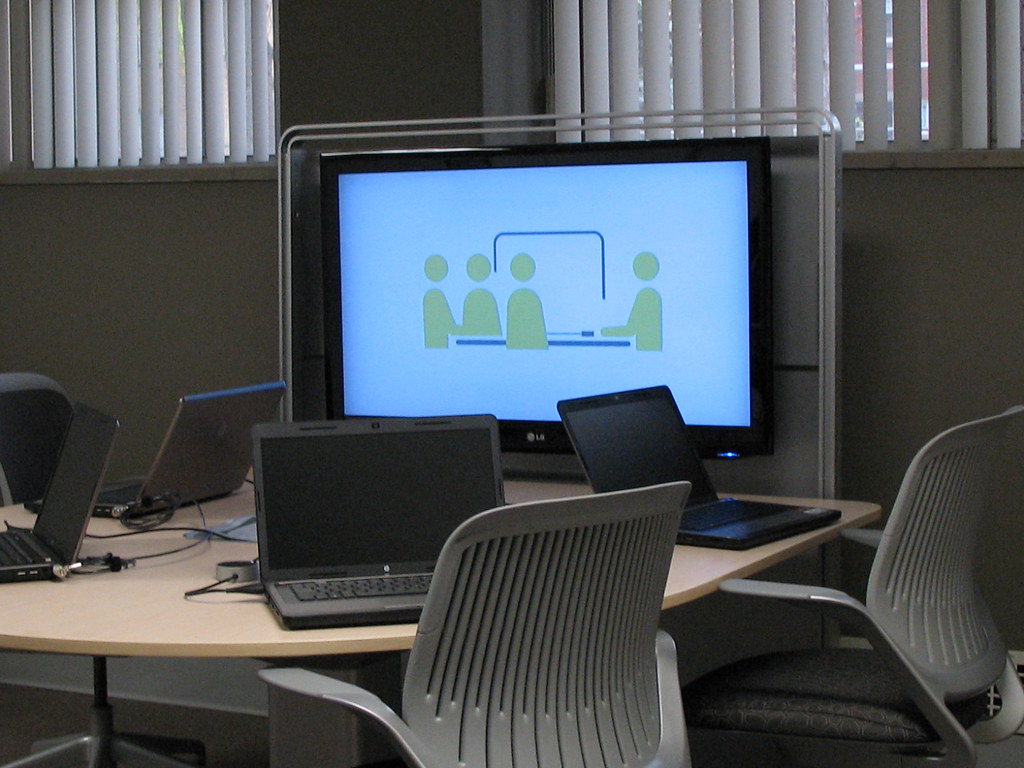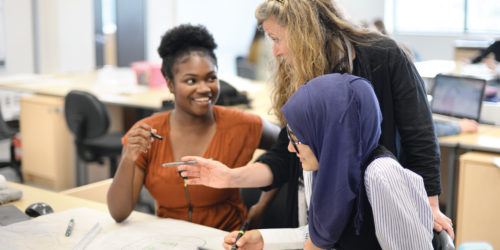
Supporting Marked Group Writing Assignments
Prepared by the Teaching & Learning team, this tip provides advice to faculty supporting collaborative group writing assignments, including reports and papers, as well as other types of group work projects. This tip includes suggestions for courses delivered in-person, hybrid (some real time classes, some anytime learning), or asynchronous (all anytime learning).
Group Work In Outcomes-Based Education
Graded group work assignments build students’ collaboration abilities while progressing learning towards identified knowledge and skill outcomes. In outcomes-based education, each student must show they have achieved all learning outcomes associated with the assignment, which means group members must work on tasks together, rather than “divide and conquer” tasks individually.
As group work success depends in part on group development, it is important to plan to support student groups at every stage (Tuckman & Jensen, 1977).
Forming and Norming Group Work
“How will I form groups? How can I support teams as they establish working norms for the group? What will the opportunities and challenges be, given the mode of delivery of my course?
Here are some tips for supporting groups in the synchronous, hybrid, and asynchronous modes of course delivery.
In-Person Group Work
- Prior to forming group, normalize work that students do together as well as independently to have students practice productive group work.
- Choose a group formation strategy early (e.g., random, selecting topics, self-selected groupings or assigned groupings). In first semester, randomizing can allow students to meet each other in person and form bonds.
- Brainstorm good group work habits, then have students complete and printed group contracts that each member can keep.
- Facilitate simple in-person communication activities to help students get comfortable with diversity. Get students moving in around the classroom with team-building icebreakers.
- Describe to students how much in-person class time they will have group work, and how much out-of time class students can expect to do on their own.
Hybrid Group Work (in-person or online synchronous and asynchronous)
- Icebreakers and group meetings should take place in synchronous portions of hybrid classes, where possible
- As a class, co-create norms of attitudes and behaviour in group work in synchronous and asynchronous work spaces
- Describe considerations for academic integrity breaches. Have students practice checking APA style and references in breakout groups activities.
- In the synchronous classroom, show how examples of asynchronous activities and tools that can be done to support group work.
- Do not assume that the quality of synchronous collaboration will automatically continue asynchronously. Encourage and remind students to keep in touch when they are not in the synchronous classroom together.
Asynchronous Group Work (fully online)
- Used a form survey to learn about students, which can inform group selection (e.g., time zones, etc.)
- Assign groups early, then respond to concerns. Use eConestoga to self-select group members or group. Do not assume that just because students are working asynchronously they do not know each other–sometimes students will prefer to be grouped by whom they know.
- Send emails to the groups early in group work, asking team members to “Reply all.”
- Create or recommend an online communication/sharing channel (eConestoga or MS Teams) for groups.
- Describe in an email, announcement, or video common group work norms, as well as the types of tasks and roles that students can take on in asynchronous group work.
- Let students know in assignment instructions a suggested minimum number of group work meetings in a particular period.
- Create a digital contract, and ask student groups to work together to co-create it (either create a base that students can add to, or have a checklists from which students can select options.
- For larger projects, have students create a shared project timeline with milestones. Ask students to post in a shared online space.
Group work starts at the forming and norming stages: groups are established, goals are set, and expectations about healthy group dynamics are shared (Tuckman & Jensen, 1977). Helping groups to form and norm can minimize group work challenges and unproductive group dynamics later in the life cycle.
Group Storming, Tracking Process and Progress
“What are the issues groups are most likely to experience? How will students keep track of their work? How can I monitor group progress in the mode of delivery of my course?
In-Person
- Describe in class your expectations, including your immediate notification about any challenges (e.g., no shows) either after class or in an email.
- Show students how to use co-authored documents to track and trace group member contributions. Have students practice with these documents in class, if possible.
- Use in-class time to monitor groups and how they are working together. Spend time with each group.
- Take note of those who attend group meetings, and reach out to those who do not attend class
- Create a progress checklist, and ask teams to review and share what they have completed.
Hybrid
- Provide online resources in the course shell to promote self-regulation.
- Review assignment riders in announcements, emails, and short videos to ensure students are equipped to tackle things on their own.
- Monitor discussion group boards and messages among group members. Note where there is silence.
- Provide opportunities for students to work through a problem or provide holistic feedback on other team’s work during synchronous class time.
- Encourage students to take minutes for any meetings that the team has (including attendance).
- Encourage teams to reach out if a student has not been answering messages or participating: meet with that student synchronously as soon as possible to re-establish expectations.
Asynchronous
- Ask students to keep a log of their individual actions, activities, and contributions to team work.
- Provide a shared calendar for teams, and ask students to use it to schedule team meetings.
- Provide an online checklist or regular email update on progress.
- Use class announcements or a shared class calendar to remind students what milestones should be completed.
- Create or curate video overviews of collaboration and communication tools (OneDrive docs, etc.).
- Remind students that in an asynchronous class students are not expected to meet in-person and on campus.
- If you use a tool for collaboration (eConestoga/Teams), monitor activity. Note students who are not participating, and send a check-in email.
Group work continues with the exchange of ideas, allocation of work, and developing the assignment collaboratively. The storming stage—when ideas, personalities, and schedules conflict—is a time for you to actively track progress, ask students to keep evidence of work, and monitor potential group breakdowns (Ferdous & Karim 2019).
Assignment Riders, Academic Integrity, and Rubrics
“What assignment information is important to describe and highlight? How can academic misconduct be discouraged? What rubric items do I need to consider for grading group assignments?
Riders are explanatory statements that convey assignment instructions and expectations, including the rights and responsibilities of both students and faculty. For example, The professor reserves the right to assign individual marks if a student is found not to have contributed to the group work. Assignment instructions for group work can help to clarify your expectations about group member collaboration, as well as maintaining academic integrity in group assignment work.
Tips for Riders and Academic Integrity
- Provide scaffolding around development of professional skills and workplace application of group working skills. Note that the smaller the group the less likely there will be challenges of AI.
- Describe what happens in cases of plagiarism or cheating, including the consequences of academic offenses.
- Explain that if one student cheats the other members of the group will not be penalized, but emphasize that evidence of individual contributions should be kept.
- Provide resources relating to APA and correct citation/reference practiceGive examples of academic integrity in your class meetings and/or on video recordings.
Rubrics are matrix-style marking schemes for assessing group writing assignments; their criteria should connect directly to assignment outcomes and instructions.
Tips for Marking Schemes/Rubrics
- Use simple marking schemes for group work less than 10%; use matrix rubrics for group work writing assignments between 10% and 40%
- Provide a group rubric for the overall assessment, and add a separate peer assessment item if required (less than 10%).
- Show students the group work rubric and explain how their work relies on collaboration. Provide a short video recording that explains the assignment and the rubric to which students may refer.
- Give marks to individual students for their contribution to the group work process, such as fulfilling key roles that support group work or individual reflection on group work activities.
See Rubric Items and Riders for more examples.
Asynchronous Group Work Challenges
Collaboration in group work requires trust, communication, and shared processes (Langston et al., 2018), all of which can be more even difficult to achieve when students never meet in person or in real time. Consider these additional challenges that students face in asynchronous group work as you plan:
- No shared synchronous time: Without a class schedule, it is more difficult to find common time to meet. Students often take online courses because anytime learning provides schedule flexibility.
- Limited rapport: There are some students that faculty have never seen, and some students may not know or have never seen each other. Course structure and activities may not be built to support building community.
- Technology challenges: Students may not have experience with collaboration technology, or may have limited access to technology that allows them to collaborate
- Staying on task and on time: Without established tools and processes, and with group members working independently, it can be a challenge to maintain a group timeline.
- Monitoring group work: Without synchronous time, students are required to produce or show materials that demonstrate their process. Faculty may need to do additional work to track and establish check ins with groups to ensure they are on task.
- Motivation and accountability: Students must be self-motivated to take the initiative, meet, get to know each other, and work together despite the technological and schedule barriers. Independent, asynchronous group work can lead to free-riding, and it can be difficult to find ways to ensure that students make equitable contributions to group work.
References
Ferdous, T., & Karim, A. (2019). Working in groups outside the classroom: Affective challenges and probable Ssolutions. International Journal of Instruction, 12(3), 1308-1470. https://files.eric.ed.gov/fulltext/EJ1220227.pdf
Langton, N., Robbins, S. P., & Robbins, S. P. (2007). Organizational behaviour: Concepts, controversies, applications. Toronto: Pearson Prentice Hall.
Tuckman, B.W., & Jensen, M.C. (1977). ‘Stages of small group development revisited’, Group and Organizational Studies, 2, 419-427.






